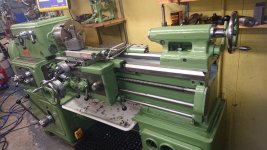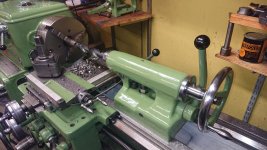Lumberjack
Hot Rolled
- Joined
- Jun 3, 2006
- Location
- Sweden
Hi,
Thought I´d share a little update on my lat(h)est project.
It´s my old stanko 1a616. I asked a few questions previously regarding the treatment of hard beds by means of possible scraping and grinding and gotten many good advise along the road. Short background on me in this context of this is a year ago I never held a scraper. However I was a bit interested and was planning to take the scraping class in Norway in 2014 but missed it but when it came about in 2017 I was informed and could not resist to join. It was great week of good fun among likeminded people. So during this winter I decided that, after lots of practice in the workshop and a local scrapefest hosted in Norway, it was time to take on the lathe.
The lathe is stout being a 13” swing x 27 in centredistance weighing in at 1500kg / #3000. Bed is nearly 2x centre height and the sadle wings are approx 21” wide. Also the crosslide has reasonable dimensions. The 4kW motor generates a speed range of 9-1800 rpm and max allowed torque on the spindle is approx 600Nm peaking at about 30-40 rpm as I recall. These factors made me both buy the lathe and use it for my home workshop needs for about 10 yrs now.
After taking the scraping class and learning lots more about inspecting and measuring machine tools I started realising that Hmmm, maybe there is a bit to work on lathe itself... However main issue during use was related to parting of, that was never easy. But the vibrations were hard to find out exactly where they came from. Some of the common tell-tale-tests such as tapping the sadle wings or prying shimstock into the slideways.
The bed wear I have made representation in a 3D model you can see and the measuring protocol, I could hardly believe it was that much. I mean, I had used it fairly sucessfully albeit being an ameatuer. I believe I can thank the inherent geometry of the lathe for compensating alot of the wear, it also gives me hope the lathe will be working nicely once completed.
Status right now.
Bed is completed, might refine surface of the flat ways a bit further while I´m working the carriage and crosslide.
I´m working on the crosslide now. Top surface was ir-regulary out of flat, both around the T-slot but also other mysterious shape... Thick on left side etc. I thought it was maybe bent first, but no. Thick it was. Underside was actually rather ok, just to scrape straight down really. So top & bottom is roughed in at the mooment.
The sides were slanted in both directions by tenths - of a millimetre! First side I scraped in, about 0,2mm along (12”) and across the height (1 ½”) also 0,2mm. I took that as scraping practice but for the other side I had the mill "talk to it" in the afternoon today.
The carriage / saddle, I´ve made initial measurements on it and while having proper signs of wear it appears main geometry is a not too far out ok, within scraping distance. I guess it was out of geometry from the start and the wear is uneven and still it looks ok, mainly relating to the relation between the bedways and crosslide ways. Next step here is to drill & mill connections, channels and oil grooves needed to install a one shot lube system and fit the crosslide to it.
Being an ameature I mainly post this here to share that your advises come in to use and I really appreciate comments, questions and input.
What intimidates me most right now after having negotiated the bed is actually the tailstock as the bed has come down approx 0,06mm and after scraping the sliding surfaces of the tailstock that one will also come down a few hundreds of a mm. And that´s where my thoughts are going mainly... How to rectify the height of the tailstock. One obvious solution is of course to pull the head stock but I´d rather not. I see many re-bore the barrel, but the barrel itself and the locking of it appear rather ok so that seems to be a fix of what is not broken... Leaving me with some way of shiming the foot of the tailstock. Maybe mill it out and install "riser pads", basically like turctiting it but with thicker CI blocks. I don´t know... What ya say folks?
Pics show lathe, overview of bed as is now and the levelness along rear flat way (carriage way).
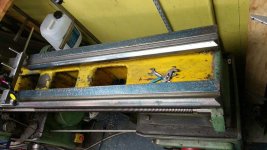


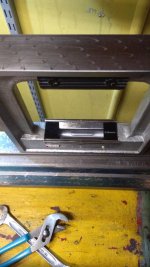
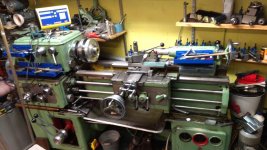
Thought I´d share a little update on my lat(h)est project.
It´s my old stanko 1a616. I asked a few questions previously regarding the treatment of hard beds by means of possible scraping and grinding and gotten many good advise along the road. Short background on me in this context of this is a year ago I never held a scraper. However I was a bit interested and was planning to take the scraping class in Norway in 2014 but missed it but when it came about in 2017 I was informed and could not resist to join. It was great week of good fun among likeminded people. So during this winter I decided that, after lots of practice in the workshop and a local scrapefest hosted in Norway, it was time to take on the lathe.
The lathe is stout being a 13” swing x 27 in centredistance weighing in at 1500kg / #3000. Bed is nearly 2x centre height and the sadle wings are approx 21” wide. Also the crosslide has reasonable dimensions. The 4kW motor generates a speed range of 9-1800 rpm and max allowed torque on the spindle is approx 600Nm peaking at about 30-40 rpm as I recall. These factors made me both buy the lathe and use it for my home workshop needs for about 10 yrs now.
After taking the scraping class and learning lots more about inspecting and measuring machine tools I started realising that Hmmm, maybe there is a bit to work on lathe itself... However main issue during use was related to parting of, that was never easy. But the vibrations were hard to find out exactly where they came from. Some of the common tell-tale-tests such as tapping the sadle wings or prying shimstock into the slideways.
The bed wear I have made representation in a 3D model you can see and the measuring protocol, I could hardly believe it was that much. I mean, I had used it fairly sucessfully albeit being an ameatuer. I believe I can thank the inherent geometry of the lathe for compensating alot of the wear, it also gives me hope the lathe will be working nicely once completed.
Status right now.
Bed is completed, might refine surface of the flat ways a bit further while I´m working the carriage and crosslide.
I´m working on the crosslide now. Top surface was ir-regulary out of flat, both around the T-slot but also other mysterious shape... Thick on left side etc. I thought it was maybe bent first, but no. Thick it was. Underside was actually rather ok, just to scrape straight down really. So top & bottom is roughed in at the mooment.
The sides were slanted in both directions by tenths - of a millimetre! First side I scraped in, about 0,2mm along (12”) and across the height (1 ½”) also 0,2mm. I took that as scraping practice but for the other side I had the mill "talk to it" in the afternoon today.
The carriage / saddle, I´ve made initial measurements on it and while having proper signs of wear it appears main geometry is a not too far out ok, within scraping distance. I guess it was out of geometry from the start and the wear is uneven and still it looks ok, mainly relating to the relation between the bedways and crosslide ways. Next step here is to drill & mill connections, channels and oil grooves needed to install a one shot lube system and fit the crosslide to it.
Being an ameature I mainly post this here to share that your advises come in to use and I really appreciate comments, questions and input.
What intimidates me most right now after having negotiated the bed is actually the tailstock as the bed has come down approx 0,06mm and after scraping the sliding surfaces of the tailstock that one will also come down a few hundreds of a mm. And that´s where my thoughts are going mainly... How to rectify the height of the tailstock. One obvious solution is of course to pull the head stock but I´d rather not. I see many re-bore the barrel, but the barrel itself and the locking of it appear rather ok so that seems to be a fix of what is not broken... Leaving me with some way of shiming the foot of the tailstock. Maybe mill it out and install "riser pads", basically like turctiting it but with thicker CI blocks. I don´t know... What ya say folks?
Pics show lathe, overview of bed as is now and the levelness along rear flat way (carriage way).





Last edited:


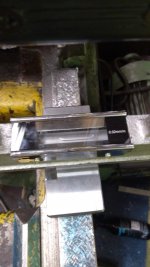







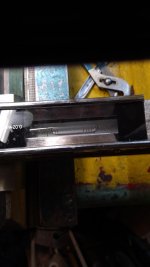

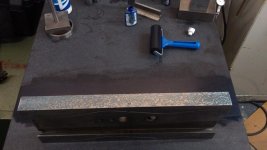

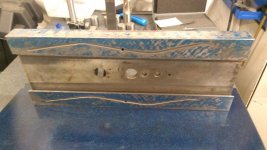


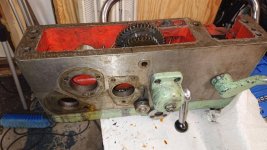
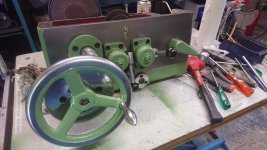



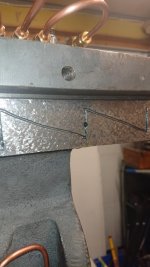

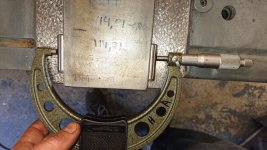









 I´ve also noticed a secondary condition following presenting in a tendancy for hoarding stones, preferably vintage granite...
I´ve also noticed a secondary condition following presenting in a tendancy for hoarding stones, preferably vintage granite...
